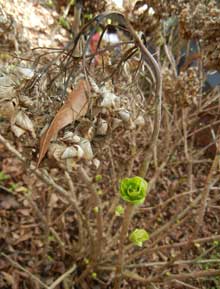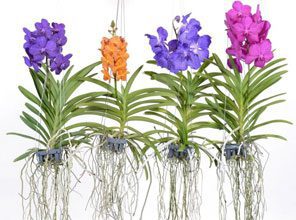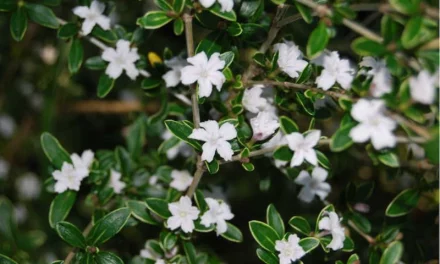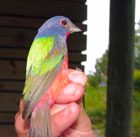 Okay, my panic is setting in now. The winter never really got seriously wintry for long enough to count, and the severe cold that did come was soon replaced with spring-like sun and warmth for days on end. Then there were those March winds in February; and those April showers, also in February.
Okay, my panic is setting in now. The winter never really got seriously wintry for long enough to count, and the severe cold that did come was soon replaced with spring-like sun and warmth for days on end. Then there were those March winds in February; and those April showers, also in February.
All of this was ideal for putting off ’til another day all my necessary tasks and preparations in the garden – preparations which I should do to make a healthy and lush garden in the coming months.
I did manage occasionally to get some of my assigned tasks done. Clumps of daylilies had gotten severely crowded over the last few years, so last week I dug up all of them. Once they were out of the ground, it was easy to pry the big clumps apart into smaller ones. That provided the perfect opportunity to remove by hand those white grub-like roots of the despised Florida betony, an absolutely pernicious weed which seems to come up everywhere. Now with three times as many daylily plants as before, I replanted most in well-prepared (and well weeded!) beds, already showing new spring growth. With the leftover plants, some went to my sister’s garden; some went to the wonderful lady who helps us take care of my mother; and some will be given to plant sales coming up soon.
I did manage to find the energy the week before to start the essential job of camellia hygiene. As everyone knows, camellias are among the most spectacularly beautiful and most beloved of the heritage garden plants of the lower south. More and more people, however, are discovering that camellias are increasingly vulnerable to a fungal disease called camellia flower blight. Fortunately, the blight does not threaten the health of the plant; rather, the fungus infects the blooms on the plant, turning them from the glorious pinks, reds, and whites we expect to dried-up brown masses.
There is no cure so far for the flower blight, although research is franticly being done all over the world. Our only accepted recourse at this point is to maintain a scrupulous schedule of careful clean-up. The fungus is understood to go from the fallen infected flower into the ground; there it eventually develops a threadlike fungal body, which is protected and encouraged by leafy mulch. Then the following late winter, as warmer weather approaches, the fungus sends up a fruiting body which disperses the spores. These spores may land on a nearby camellia flower, and it becomes part of the cycle as it turns brown and falls off.
The japonica camellias, the ones which bloom in late winter, are the ones particularly vulnerable. Sasanqua camellias and other fall-blooming and early winter-blooming camellias have largely avoided the blight, since their bloom period is before the fungus releases its spores. However, as our climate warms and as winter temperatures often remain at springtime warmth, the fungus will produce its spores at earlier times as well.
So, as I say, hygiene is our only weapon. I rake up all fallen flowers beneath my camellias all during the bloom season. This means that – for me – mulch is pointless during this keep-it-clean period; so mulch, too, gets raked up. Everything – camellia mulch, fallen flowers – must be disposed of in such a way that the possible fungus does not stay in the garden. No compost bin. I burn it or take it to the county dump. Out. Get rid of it. Then once the flowering is over, and the bare ground beneath has been kept weedless and clean, I can spread a little Hollytone or Azalea/Camellia fertilizer, topdress with a little compost under the shrubs, and spread some mulch to protect the roots from our summer heat and drought.
But really, my panic has set in. The tasks I haven’t done outnumber the ones I have done by three to one.
 I absolutely, positively MUST get to the hydrangeas. Some are the wonderful blue mop-head type I gave to my late father ten years ago, others with the lace-cap bloom. Some are the native oak leaf hydrangea, which amazingly never lost their glowing red fall-colored leaves. There are several of the Pee Gee type, which have those big blobs of white flowers. And I have a number of smaller varieties which produce the most amazing range of colors and bloom for most of the growing season. There must be six or eight different species, twenty or so different cultivars, fifty or sixty plants – I can’t be bothered to actually count them. They all need attention right this minute. For most, I will treat much like what I do on the old-fashioned mopheads.
I absolutely, positively MUST get to the hydrangeas. Some are the wonderful blue mop-head type I gave to my late father ten years ago, others with the lace-cap bloom. Some are the native oak leaf hydrangea, which amazingly never lost their glowing red fall-colored leaves. There are several of the Pee Gee type, which have those big blobs of white flowers. And I have a number of smaller varieties which produce the most amazing range of colors and bloom for most of the growing season. There must be six or eight different species, twenty or so different cultivars, fifty or sixty plants – I can’t be bothered to actually count them. They all need attention right this minute. For most, I will treat much like what I do on the old-fashioned mopheads.
Most of these hydrangeas will form hidden flower buds during the winter on the ends of the branches which grew last summer. For this reason, I’m pretty careful about cutting them before they bloom – I usually don’t want to cut off those already-formed buds. However, I never hesitate to remove those old branches that are looking a little ratty, cutting them off close to the ground. Similarly, on these big healthy shrubs, dinky little branches get removed, since they’ll never do much. I like to wait to start this pruning back until I’m fairly confident there won’t be any more frosts/freezes; pruning has the amazing ability to make a plant want to send out new growth quickly, which is fantastic – unless, of course, it gets frozen and killed back. New growth is always much more vulnerable and tender, so I wait until I see a little green sprouting on the branches and check the long-range weather report. I do try very hard not to cut out more than, say, one-third of the number of branches coming up from the base.
I know gardeners often worry about when to cut off the old dried-up hydrangea blooms from the previous year. I like to leave them on until pruning time; I think they offer a little protection for the future growth buds on the plant during the cold dormant winter. Then when I decide to trim these old blooms off, I cut the tip of the branch down to the first major growth bud below the old flower head.
With the other types of hydrangeas, I do much the same. Somehow, I manage to surprise myself each year with their amazing show of color and form.
But that’s only the first task I must get to. Several of my dozens of crinum lilies need to be moved to better locations; I’m going to try roses one more time, so I’ve got to make sure they’re appropriately shaped up and in the right place; the new little greenhouse I’m building has to be completed; my tropical plants and orchids have to be prepped for their return to the outdoors. So much to do, so little time. I feel another panic attack coming on.
Will Balk, Jr., is a Master Gardener who grew up on an Agricultural Experiment Station in Barnwell County as the son, grandson, and great-grandson of accomplished gardeners. He is a past president of the Lowcountry Master Gardener Association. Currently he gardens on the family homestead in Barnwell County and tries to fight back the jungle in Northern Beaufort County.








